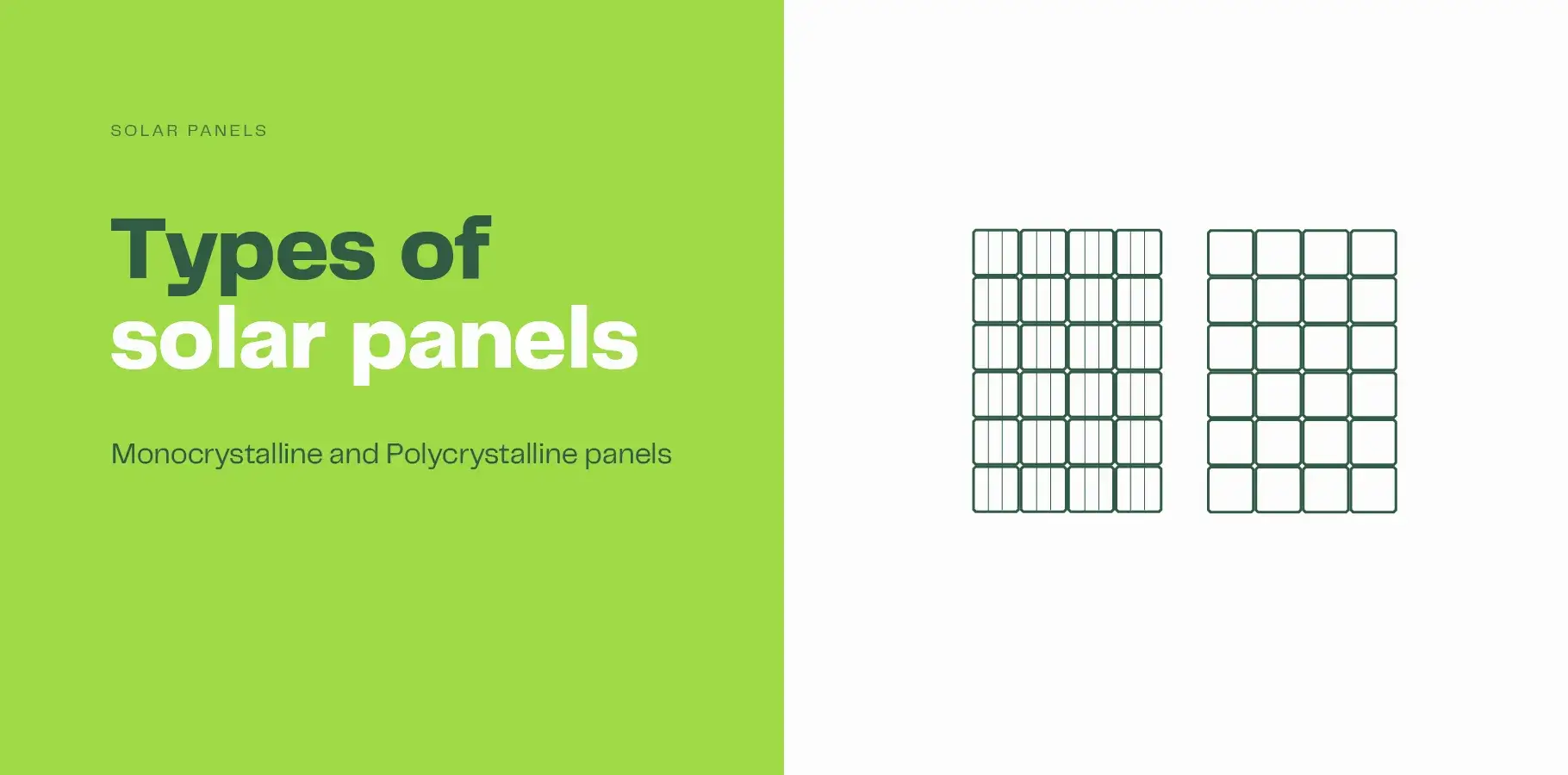Monocrystalline vs polycrystalline solar panels
Learn about the different types of solar panels.
The two most common types of solar panels installed on residential and commercial rooftops are monocrystalline and polycrystalline panels.
Their colour typically differentiates them; polycrystalline solar panels are bluer while monocrystalline panels take on a darker, almost black appearance.
Amorphous panels are a thin film panel that are more flexible and serve a purpose for portable installations or camping.

What are solar panels made of?
Both monocrystalline and polycrystalline panels are made from crystalline silicon. Amorphous panels are also made from silicon.
Differences between monocrystalline and polycrystalline panels
Monocrystalline and polycrystalline solar panels are both suitable for use in Australia. We explain the differences between the two popular types of panels:
Monocrystalline vs polycrystalline:
| Differences | Monocrystalline | Polycrystalline |
|---|---|---|
| Appearance: | Black | Blue with crystal structure |
| Manufacture process: | More intensive | Simple |
| Efficiency: | 18 – 22% | 15 – 17% |
| Roof space: | Minimises area | Needs more space |
| Price: | More expensive | Less expensive |
| Temperature performance: | Effective | Effective |
Appearance
It is easy to distinguish between monocrystalline and polycrystalline panels; mono panels tend to be much darker almost black in appearance. Polycrystalline panels, on the other hand, are much bluer and, the texture of the crystal is visible in the actual panel.

Manufacture process
There is a slight difference in the manufacturing process of different types of solar panels. Polycrystalline panels are made from multi-crystalline silicon that is melted and placed in square moulds before being cut into wafers. Monocrystalline panels are made from cylindrical silicon ingots that are cut into wafers; they feature more pure silicon than polycrystalline panels, and this is why they are more efficient.
Panel efficiency
Solar panel efficiency is the rate at which a panel converts sunlight into electricity. Monocrystalline panels are more efficient than polycrystalline modules with the top of the range SunPower panels achieving 22% efficiency. The Monocrystalline panels typically have an efficiency of between 18 – 22% while polycrystalline panels achieve between 15 – 17% efficiency.
Roof space
The higher the efficiency of the panel, the less of them you will need to make up an entire system. If space is an issue on your rooftop, you should consider monocrystalline panels as they are more efficient and therefore you will need less of them to achieve your desired system size.
Price difference
Due to their higher efficiency and silicon content, monocrystalline panels are more expensive than polycrystalline panels. The cost of the panels varies further between different manufacturing brands. You have to remember that while you pay more for monocrystalline panels, you need less of them.
Temperature coefficient
There is a minor difference in the performance of monocrystalline and polycrystalline panels in hot temperature conditions. The temperature coefficient varies slightly between the two different modules from the same manufacturer; monocrystalline panels are rated to perform between 0.5 – 1% better in high temperature.
Monocrystalline solar panels
Monocrystalline panels are made from cylindrical silicon; they have a higher silicon content than polycrystalline panels and operate at higher efficiency.
The dark blue or black appearance characterises monocrystalline panels, but there are other traits that differentiate them from other types of panels:
Characteristics of monocrystalline solar panels
- Dark blue or black appearance
- Feature more pure silicon than other panels
- The panels are highly efficient
- Monocrystalline panels, therefore, take up less roof space
- Longevity is a trait of mono panels
- Monocrystalline panels are typically more expensive
Monocrystalline solar panel prices
It is often hard to compare panel prices as most modules come with a system that includes the inverter and the cost of installation. To get around this, we surveyed module prices to compare the price difference between monocrystalline and polycrystalline panels. Monocrystalline panels operate at a higher efficiency, which means you need less of them, so we broke down the pricing to find the cost per watt of each panel.
- Mono panels are 12 – 20% more expensive
We found that on average, monocrystalline panels were between 12 – 20% more expensive compared to their polycrystalline counterparts from the same manufacturer.
Polycrystalline solar panels
Polycrystalline panels are bluer in appearance, and the crystal formation within the module is visible. Although there are differences between polycrystalline and monocrystalline panels, little separates the two types of modules in performance. You may be drawn to polycrystalline panels because they are a little cheaper, the downside is they will take up a little more of your roof space.
How are polycrystalline solar panels made?
Polycrystalline panels are made from silicon. The silicon is melted down and poured into a mould before being cut into thin wafers. The manufacturing process is more efficient than that used for monocrystalline panels, though there is less pure silicon content.
Advantages of polycrystalline solar panels
Polycrystalline panels are a high performance module that have several advantages over other types of panels:
- Less expensive than monocrystalline panels
- More efficient manufacturing process
- Very popular
- Durable
- Benefit from large R&D investment
Polycrystalline solar panel prices
While monocrystalline panels produce more power per square metre, polycrystalline panels are not as expensive. If we break down the price of panels to the $ / watt (dollar cost per watt), polycrystalline panels are still cheaper than monocrystalline modules.
- Poly panels are typically 12 – 20% less expensive
A slightly cheaper alternative
Polycrystalline solar panels are a slightly cheaper alternative than their monocrystalline counterparts.
Which type of panel is best?
Monocrystalline panels are more efficient and for that reason can be considered a higher quality panel; this also means they are more expensive. Very little separates the panels in pure performance.
Why buy monocrystalline panels?
- You have a shortage of roof space and need a more efficient panel
- The darker mono aesthetics of the panel are more appealing
Why buy polycrystalline panels?
- You may find they provide a cheaper alternative

Are you ready for the benefits of solar?
Get 3 free quotes and start your journey towards making the switch.
Get free quotes